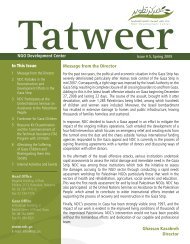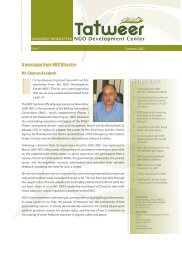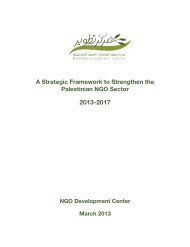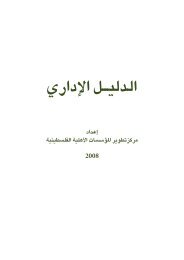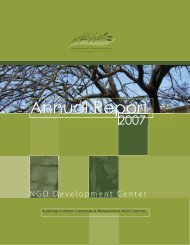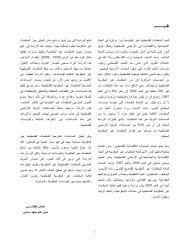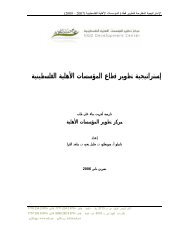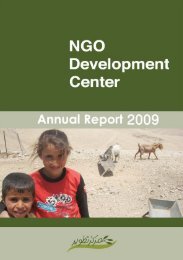Tracking External Donor Funding.pdf - NDC
Tracking External Donor Funding.pdf - NDC
Tracking External Donor Funding.pdf - NDC
Create successful ePaper yourself
Turn your PDF publications into a flip-book with our unique Google optimized e-Paper software.
3.6.4.5 <strong>External</strong> <strong>Funding</strong> to Social Service-Based<br />
PNGOs<br />
Health Services<br />
The percentage of PNGOs engaged in Health Services<br />
was at its peak in 2001 with the start of the Intifada, after<br />
which it declines sharply, over 10%, into 2002. From<br />
then on there is a steady decline, broken only by an<br />
increase in 2006, presumably from the shifting of some<br />
money out of the public health sector and into PNGOs.<br />
From 2007 to 2008, the funding remained at a steady<br />
15%.<br />
Unlike the overall trend and governmental donors, INGO<br />
funds declined straight through to 2008, without<br />
climbing in 2006 in response to the elections. The INGO<br />
donor sector also apportions a higher percentage of its<br />
aid to health related activities that the Governmental<br />
sector, presumably because the latter also funds the<br />
Palestinian Ministry of Health (MoH).<br />
In 2006, MAS measured external financing to PNGOs in<br />
the Health Services sector as covering a total of 50.2% of<br />
their budgets. As many health INGOs offer their services<br />
at a price, the amount of self-financing in this sector is<br />
far higher than the others, with the exception of family<br />
planning.<br />
Elderly Care<br />
According to our survey, Elderly Care is not a PNGO<br />
sector heavily funded by external donors. The data may<br />
also be open to the possibility of respondents including<br />
Elderly Care projects that are part of larger health<br />
programs into the Health Services sector.<br />
In 2006, Elderly Care PNGOs only received 37.7% of<br />
their budget from international aid. In contrast to most<br />
other PNGOs, this sector receives a high percentage of<br />
aid from self-financing revenues (20%), local sources<br />
(28.3%) and from the Diaspora (11.1%) (MAS,<br />
2007:80).<br />
Disabled Care<br />
After the height of the Intifada, and presumably in the<br />
wake of intense violence, the Disability Care sector<br />
began to grow. It peaked in 2003 at 6.74%, before<br />
remaining steady at around 5% of total external aid to<br />
PNGOs into 2008.<br />
Unlike the overall trend in aid, INGO donor funding to<br />
PNGOs working in the disabilities sector peaks in 2005,<br />
at the same time when Governmental funding is at an all<br />
time low, less than 1%. This could in part be due to the<br />
fact that Governmental donors had shifted so much of<br />
their funding into the sector of Human Rights,<br />
Democracy and Good Governance in 2005 in advance of<br />
the elections.<br />
Disabled Care received 42% of its funding from external<br />
aid in 2006 and a total of 31.9% of its funding from selffinancing<br />
- much like PNGOs engaged in the more<br />
general health sector (MAS, 2007:80).<br />
Family Planning<br />
According to our survey, external donor funding to<br />
PNGO programs in Family Planning is almost<br />
nonexistent. As we assume this is untrue, we suspect that<br />
a number of respondents allocated these projects to other<br />
sectors, such as Health Services or Women’s Affairs.<br />
However the low figures are not too far off when we<br />
look at the percentage of external aid in Family Planning<br />
PNGOs’ budgets in 2006. According to MAS survey of<br />
PNGOs in 2007, only 13.4% of funds came from abroad,<br />
while a full 78.4% of aid came from self-financing. 2005<br />
represents the peak in donor funding to the sector and the<br />
trend is mimicked by both Governmental and INGO<br />
donors.<br />
Children’s Activities<br />
<strong>External</strong> aid to PNGOs working in Children’s Activities<br />
decreased dramatically between 2001 and 2002. In 2003<br />
it began to recover dramatically, finally reaching its peak<br />
of 8.04% in 2004. Between 2004 and 2005 there was a<br />
dramatic drop in aid to the sector, presumably following<br />
a shift in funding toward the PA or into sectors such as<br />
Enhancing Democracy or Good Governance.<br />
Both Governmental and INGO donors generally follow<br />
the overall pattern of aid to the sector – with the former<br />
apportioning a higher percentage of its disbursements<br />
from 2003 forward. According to previous MAS<br />
mappings, 75.6% of the budgets of PNGOs working in<br />
Children’s Activities came from external aid (MAS,<br />
2007:80).<br />
Youth and Sports<br />
Unlike work with the children’s sector, Youth and Sports<br />
increased dramatically during the Intifada and peaked in<br />
2003 at 3.62% of total aid. Since 2003, funding to the<br />
sector has steadily declined. The increase in funding<br />
throughout the Intifada was due largely to INGO donors,<br />
who also apportioned a higher percentage of their aid to<br />
the sector in general.<br />
It is important to note that Youth and Sports<br />
organizations are the most numerous type of PNGO in<br />
the WB&GS, and at the same time, one of the sectors<br />
receiving the least amount of external aid. <strong>External</strong> aid<br />
made up 59.5% of Youth and Sport PNGO budgets in<br />
2006. Local funding to the sector is higher than any<br />
other, with the exception of elderly care, at 19.6% of<br />
their operating budgets (MAS, 2007:80).<br />
43


